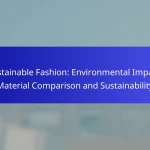Which sustainable fashion brands are leading in the US?
Several sustainable fashion brands are making significant strides in the US market, focusing on eco-friendly materials and ethical production practices. Brands like Patagonia, Eileen Fisher, Reformation, Everlane, and Outerknown are at the forefront, each offering unique approaches to sustainability.
Patagonia
Patagonia is renowned for its commitment to environmental responsibility and social activism. The brand uses recycled materials and organic cotton, and it actively encourages customers to repair rather than replace their clothing through its Worn Wear program.
Additionally, Patagonia donates a percentage of its profits to environmental causes, reinforcing its mission to protect the planet. This dedication to sustainability makes it a leader in the eco-fashion movement.
Eileen Fisher
Eileen Fisher emphasizes simplicity and sustainability in its designs, focusing on timeless styles that promote longevity. The brand uses organic and renewable fibers, and it has a robust take-back program that encourages customers to return used garments for recycling or resale.
With a commitment to fair labor practices, Eileen Fisher ensures that its supply chain is transparent and ethical, making it a trusted choice for conscious consumers.
Reformation
Reformation is known for its trendy styles and commitment to sustainability, using eco-friendly materials and practices in its production. The brand tracks its environmental impact and provides customers with detailed information on the sustainability of each item.
Reformation also prioritizes ethical labor practices, ensuring fair wages and safe working conditions for its employees. This combination of style and sustainability appeals to a younger, eco-conscious audience.
Everlane
Everlane focuses on radical transparency, providing customers with insights into its pricing and production processes. The brand uses high-quality materials and partners with ethical factories to ensure fair labor practices.
Everlane’s commitment to sustainability includes a range of eco-friendly products, such as its ReNew line made from recycled plastic bottles. This approach allows consumers to make informed choices while supporting sustainable fashion.
Outerknown
Outerknown, co-founded by surfer Kelly Slater, emphasizes sustainability through its use of organic and recycled materials. The brand is dedicated to fair labor practices and transparency, ensuring that workers are treated ethically throughout the supply chain.
Outerknown also focuses on creating durable clothing designed to last, reducing the need for frequent replacements. This commitment to quality and sustainability resonates with environmentally conscious consumers seeking stylish options.
How do sustainable fashion brands impact the environment?
Sustainable fashion brands significantly reduce their environmental impact by implementing practices that lower carbon emissions, minimize waste, and utilize eco-friendly materials. These brands aim to create a more responsible fashion industry that prioritizes the planet’s health alongside consumer needs.
Reduced carbon footprint
Sustainable fashion brands focus on reducing their carbon footprint through various strategies such as using renewable energy sources in production and optimizing supply chains. By sourcing materials locally, they can also decrease transportation emissions, which contributes to lower overall carbon output.
Many brands are adopting carbon offset programs, investing in reforestation or renewable energy projects to balance out their emissions. Consumers can support these initiatives by choosing brands that transparently report their carbon footprint and sustainability efforts.
Waste reduction practices
Waste reduction is a core principle for sustainable fashion brands, which often implement practices like recycling, upcycling, and producing limited collections to minimize excess inventory. These methods help divert textiles from landfills and reduce the overall waste generated by the fashion industry.
Brands may also offer take-back programs, encouraging consumers to return used clothing for recycling or resale. This not only promotes a circular economy but also raises awareness about the importance of responsible consumption.
Use of eco-friendly materials
Eco-friendly materials are essential to sustainable fashion, as they often require fewer resources and generate less pollution during production. Common materials include organic cotton, Tencel, and recycled polyester, which are designed to have a lower environmental impact compared to conventional fabrics.
When selecting sustainable brands, look for certifications such as GOTS (Global Organic Textile Standard) or OEKO-TEX, which indicate adherence to strict environmental and social criteria. Supporting brands that prioritize these materials helps drive demand for more sustainable practices in the fashion industry.
What are the key features of sustainable fashion brands?
Sustainable fashion brands focus on minimizing their environmental impact while promoting ethical practices. Key features include ethical sourcing, transparency in production, and fair labor practices, all aimed at creating a more responsible fashion industry.
Ethical sourcing
Ethical sourcing involves obtaining materials in a way that is environmentally friendly and socially responsible. This means using organic or recycled materials, which reduce waste and pollution. Brands often prioritize natural fibers like organic cotton or Tencel, which have a lower environmental footprint compared to conventional materials.
When evaluating a brand’s ethical sourcing, look for certifications such as GOTS (Global Organic Textile Standard) or OEKO-TEX, which indicate adherence to strict environmental and social criteria. These certifications help consumers make informed choices about the sustainability of their clothing.
Transparency in production
Transparency in production refers to the openness of brands about their manufacturing processes and supply chains. Sustainable fashion brands often disclose information about where and how their products are made, allowing consumers to understand the environmental and social impact of their purchases.
To assess a brand’s transparency, check for detailed information on their website regarding sourcing, production facilities, and the materials used. Brands that publish sustainability reports or engage in third-party audits typically demonstrate a higher level of commitment to transparency.
Fair labor practices
Fair labor practices ensure that workers involved in the fashion supply chain are treated ethically and compensated fairly. This includes providing safe working conditions, reasonable hours, and a living wage. Sustainable fashion brands often partner with factories that adhere to labor standards set by organizations like the Fair Trade Federation.
When choosing sustainable brands, look for those that are certified by Fair Trade or similar organizations. These certifications indicate that the brand is committed to upholding fair labor practices, which can help you support ethical production in the fashion industry.
How to choose sustainable fashion brands?
Choosing sustainable fashion brands involves evaluating their practices, values, and materials. Look for transparency in sourcing and production, as well as commitment to ethical labor practices and environmental stewardship.
Look for certifications
Certifications can help identify brands that adhere to sustainable practices. Look for labels like GOTS (Global Organic Textile Standard), Fair Trade, or OEKO-TEX, which indicate compliance with environmental and social standards.
These certifications often require brands to meet specific criteria regarding organic materials, fair labor practices, and chemical use. Checking for these labels can simplify your decision-making process when selecting sustainable options.
Research brand values
Understanding a brand’s values is crucial in determining its sustainability. Investigate their mission statements, sustainability reports, and social media presence to gauge their commitment to ethical practices.
Brands that prioritize sustainability often share their goals and progress openly. Look for transparency in their supply chain, community involvement, and environmental initiatives to ensure alignment with your values.
Check material sustainability
Material sustainability is a key factor in sustainable fashion. Opt for brands that use eco-friendly materials such as organic cotton, Tencel, or recycled fabrics, which have a lower environmental impact compared to conventional materials.
Additionally, consider the durability of the materials. High-quality, long-lasting fabrics reduce waste and the need for frequent replacements, making them a more sustainable choice in the long run.
What are the pricing trends for sustainable fashion?
Sustainable fashion typically features higher price points compared to fast fashion, reflecting ethical production practices and quality materials. Consumers are increasingly willing to invest in these brands, recognizing the long-term benefits of sustainable clothing.
Higher initial costs
The initial costs of sustainable fashion often exceed those of conventional brands due to more expensive materials and ethical labor practices. For example, organic cotton or recycled fabrics can be significantly pricier than standard textiles.
Shoppers may find that sustainable items range from 20% to 100% more than their fast fashion counterparts. However, these products often offer greater durability and timeless designs, which can lead to cost savings over time.
When considering sustainable fashion, it’s essential to evaluate the overall value rather than just the upfront price. Investing in quality pieces can reduce the need for frequent replacements, making them more economical in the long run.












